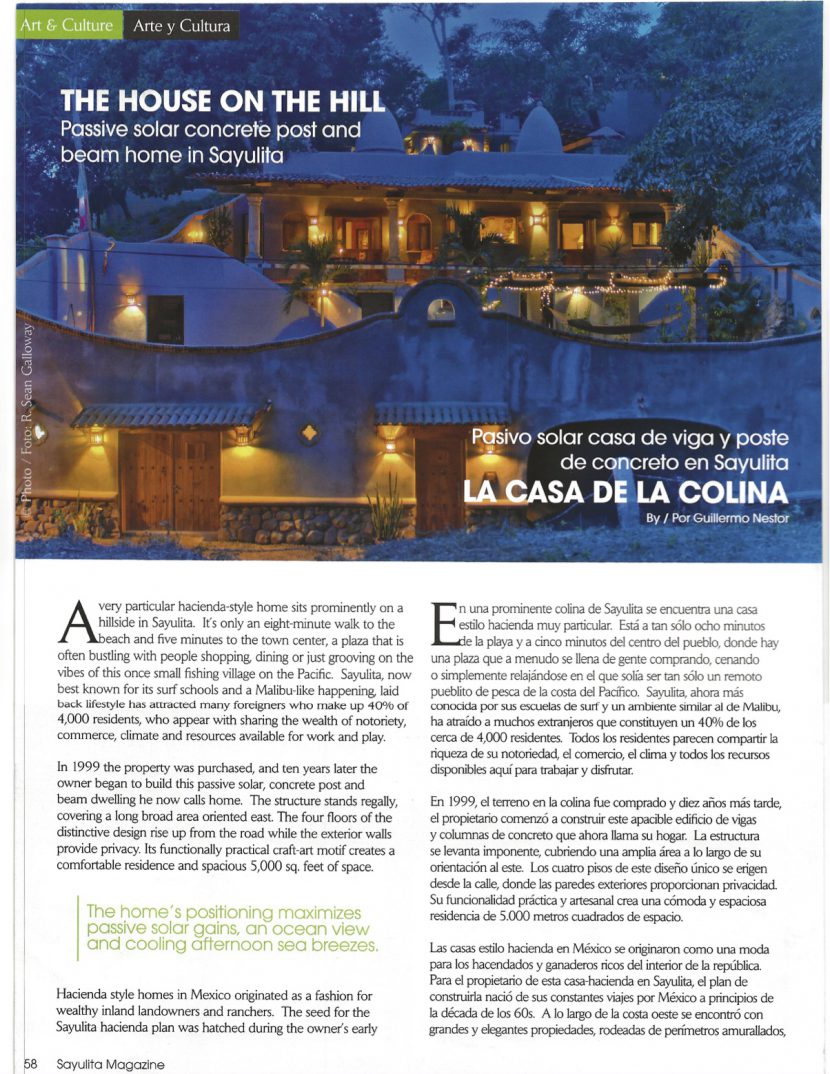2013
Passive solar concrete post and beam home in Sayulita
A very particular hacienda-style home sits prominently on a hillside in Sayulita. It’s only an eight-minute walk to the beach and five minutes to the town center, a plaza tha tis often bustling with people shopping, dining or just grooving on the vibes of this once small fishing village on the Pacific. Sayulita, now best known for its surf schools and a Malibu-like happening, laid back lifestyle has attracted many foreigners who make up 40% of 4,000 residents, who appear sharing the wealth of notoriety, commerce, climate and resources available for work and play.
In 1999 the property was purchased, and ten years later the owner began to build this passive solar, concrete post and beam dwelling he now calls home. The structure stands regally, covering a long broad area oriented east. The four floors of the distinctive design rise up from the road while the exterior walls provide privacy. Its functionally practical craft-art motif creates a comfortable residence and spacious 5,0000 sq. feet of space.
The home’s positioning maximizes passive solar gains, an ocean view and cooling afternoon sea breezes.
Hacienda style homes in Mexico originated as a fashion for wealthy inland landowners and ranchers. The seed for the Sayulita hacienda plan was hatched during the owner’s early 1960’s travel in Mexico. Along the west coast he found great and elegant estates, bound by walled perimeters, enclosing interior courtyards. Many early country homes did not have walls, but new world patrons loved the traditional style and privacy.
The entrance to the Sayulita hacienda leads to another environment greeting visitors with an interior courtyard with eye-catching features. A pergola stands in the center of a large open area with vine flowers covering, creating a shady spot. A stone outdoor-shower, both crafty and practical, adorns a corner. Ventilation domes provide cooling and a grass floor in the courtyard brings the outdoors in, setting the homes theme of inside-out living.
The hacienda style design is influenced by classical Spanish Mediterranean VIllas, a form only found in upland areas of Mexico before 1930. The hom’s positioning maximizes passive solar gains, an ocean view and cooling afternoon sea breezes.
The Hacienda on the Hill owner-built home took three years to construct with the help of two local craftsmen. Using readily available local materials and labor kept building costs down without giving up quality. The shutters, windows and doors were milled locally; clay roof tiles made nearby keep the rain out and cool the interior; concrete ventilation domes help circulate air; and the 14’ x 10” concrete block used costing .03 cents per block are cost effective but also make for a solid building.
The concrete post, beam rebar and block construction is a sound technique for Sayulita’s geographic location and climate. A clay tile roof offers protection from rain and sun, and a gutter type system directs water onto the open courtyard below. “The terrace is a key element and center of this hacienda lifestyle. The design allows for spacious outdoor-indoor spaces to entertain and enjoy,” said owner/builder Senor Joven.
Utilizing city water, power, and sewer has reduced maintenance and operating expenses, and lessened the ecological footprint. “Things take longer to get done here. The project took three people, 3 years working eight-hour days for 50 weeks each year. Picking the right maestro (master builder) is paramount importance. A lot of time, energy and money is saved with a master building who knows his trade, and where to get the best materials at the best price locally,” said Joven.
“Land ownership laws are becoming much more friendly, making it easier for non-Mexicans to own and easing some of the concerns that limited people from getting involved with owning property and building a home in Mexico,” Senor Joven brought experience with owner-built homes in the US. “The rules and guidelines are pretty much the same for building in Mexico but vary depending on local customs and structure of officials and departments,” he added.
Sayulita, called by some the gateway to the new Riviera Nayarit, a region where Fonatur, Mexico’s National Tourism Development Foundation, is creating the country’s newest tourism initiative. The project brings additional resorts, boutique hotels, spas, and golf courses to a territory that scrolls out almost 200 miles along the pristine Pacific shoreline from Punta Mita North to San Blas. The area abounds in authentic culture and customs in coastal towns and villages under a backdrop of the Sierra Madre Mountains. Riviera Nayarit is a vision of brilliant sunsets, white sand beaches, resident and migratory wildlife, unspoiled fishing communities and a history dating back to the Aztecs.




